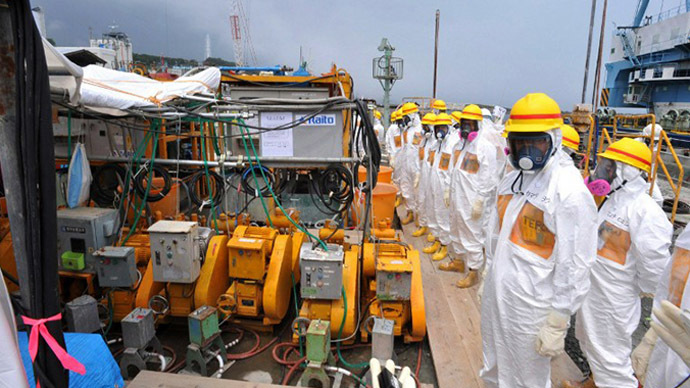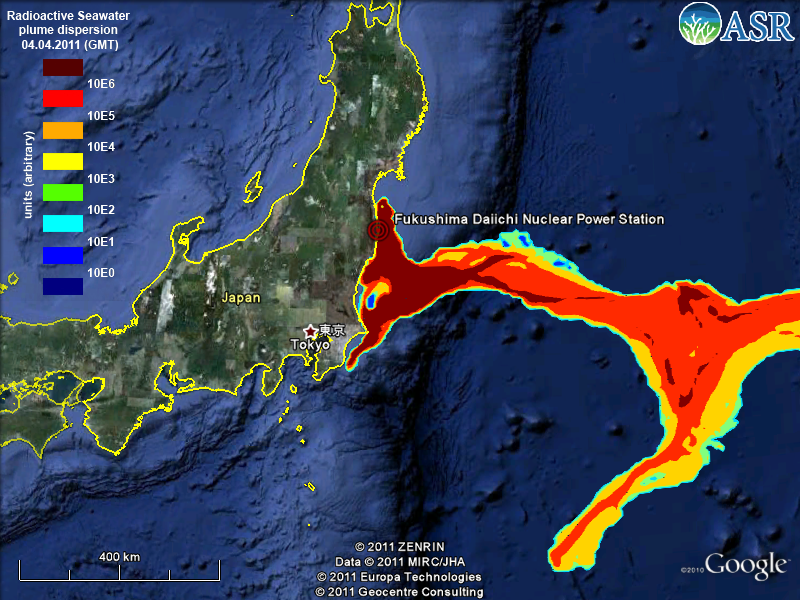It is not often that one has to call into question whether the water in the tap, the milk from the cow, and the drops that fall from the sky are fundamentally safe to consume, but this is precisely the predicament we could find if ever there were widespread nuclear contamination of the Pacific Ocean. In March 2011, an earthquake and tsunami caused a Fukushima Daiichi Nuclear Plant incident. Here are some recently collected excerpts on information from all around the reporting spectrum.

An energy map from the National Oceanic and Atmospheric Administration shows the intensity of the tsunami moving across the Pacific Ocean after the magnitude 9.0 earthquake that struck Japan. (NOAA / Center for Tsunami Research)
Recently…
Aug 12, 2013 |By North Asia correspondent Mark Willacy, ABC News Online: Fukushima plant spilling contaminated water into the sea ‘for years’
“Workers at the crippled Fukushima nuclear plant have told the ABC that contaminated water has most likely been seeping into the sea since the disaster two-and-a-half years ago. Japan’s nuclear watchdog has described the leaks as a “state of emergency”.”
Aug 12, 2013 | YUMI NAKAYAMA, The Ashi Shimbun With radiation fears rekindled, researchers seek truth off Fukushima coast
“Tokyo Electric Power Co. admitted on July 22 that contaminated water from its Fukushima plant had been flowing into the ocean. In fact, the radioactive spillage had likely continued since the meltdowns in March 2011.
Although studies show that marine animals with high radioactivity levels have been concentrated right next to the nuclear plant, TEPCO’s belated announcement has rekindled fears that all waters off the Fukushima coast are filled with radioactive substances, dealing a further blow to fishermen in the area.”

Local government officials and nuclear experts inspect a facility to prevent seeping of contamination water into the sea at Tokyo Electric Power’s (TEPCO) Fukushima Dai-ichi nuclear plant in Okuma, Fukushima prefecture. (AFP Photo)
August 11, 2013 | RT , Radioactive water overruns Fukushima barrier – TEPCO
“Contaminated groundwater accumulating under the crippled Fukushima nuclear power plant has risen 60cm above the protective barrier, and is now freely leaking into the Pacific Ocean, the plant’s operator TEPCO has admitted.
Water samples recently taken at an underground passage below the Fukushima nuclear plant showed extreme levels of radiation comparable to those taken immediately after the March 2011 catastrophe. The tested water, which had been mixing with ground water and flowing into the ocean, contained 2.35 billion Becquerels of cesium per liter – some 16 million times above the limit.”
Aug 9 2013 | Justin McCurry in Hisanohama, The Guardian: Toxic Fukushima fallout threatens fishermen’s livelihoods
The environment ministry recently announcement that 300 tonnes of contaminated groundwater from Fukushima Daiichi is still seeping over or around barriers into the Pacific every day, more than two years after it was struck by a tsunami in March 2011. Government officials said they suspected the leaks had started soon after the accident, which resulted in a nuclear meltdown.
AUG 9 2013 | PAUL HUDSON, Elite Daily Breaking News: Fukushima Radiation Affecting Americans And There’s No Way To Stop It
“Fukushima Daiichi Nuclear Plant was hit by the earthquake and tsunami of March 2011. Since then, it is estimated that 330 tons of radiation-contaminated water has been leaking into the Pacific Ocean daily. That’s correct, over 300 tons of radiation-contaminated water has been seeping into our oceans every single day for over 2 years. That’s over 250,000 tons of contaminated water that has now entered the Pacific Ocean.”
Aug 7, 2013 | Patrick J. Kiger, National Geographic News: Fukushima’s Radioactive Water Leak: What You Should Know

Tanks of radioactive water tower over workers at the disabled Fukushima nuclear plant in March 2013. Tokyo Electric Power admits contaminated water has long been leaking into the Pacific Ocean, defying containment efforts. Japan’s government views the situation as “urgent.” Photograph from Kyodo/Reuters
“How far is the radiation spreading, and how fast does it travel?
The initial gigantic deluge of contaminated water dispersed through the immediate Fukushima coastal area very quickly, according to a 2012 report by the American Nuclear Society. But it takes years for the contamination to spread over a wider area. A mathematical model developed by Changsheng Chen of the University of Massachusetts at Dartmouth and Robert Beardsley of the Woods Hole Oceanographic Institute found that radioactive particles disperse through the ocean differently at different depths. The scientists estimated that in some cases, contaminated seawater could reach the western coast of the United States in as little as five years. Buesseler thinks the process occurs a bit more rapidly, and estimates it might take three years for contamination to reach the U.S. coastline.”
A few years ago…
March 28, 2011|By Thomas H. Maugh II, Los Angeles Times: Radioactive water spilling into tunnels beneath Japanese nuclear plant; plutonium found in soil
“Highly radioactive water is building up in tunnels underneath at least three reactors at the Fukushima Daiichi nuclear power plant, impairing the ability of workers to reestablish power connections at the facility.
Officials of the Tokyo Electric Power Co., which owns the facility, also said that tests last week found trace levels of plutonium in soil outside the plant, an indication that the containment vessel of reactor No. 3, the only one that is fueled with plutonium, may have been breached.”

